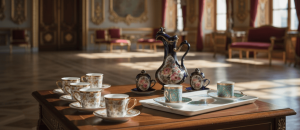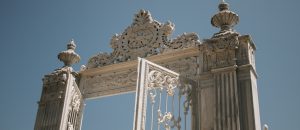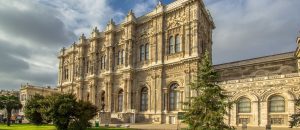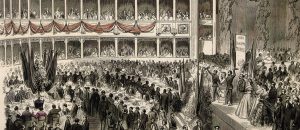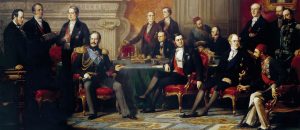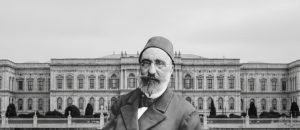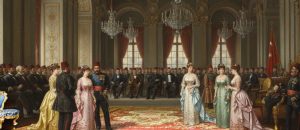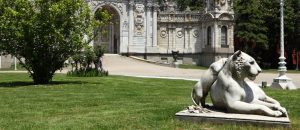Dolmabahçe Palace is a museum in its own right, not just as a whole, but also with the priceless collections it houses. If you have a specific interest – for example, if you are an art lover, a clock enthusiast, or a luxury object connoisseur – you can create your own thematic tour by stepping outside the standard itinerary. This means exploring the palace “through the collector’s eye,” tracing a special narrative within the general story. Here are two special mini-tour routes you can follow at Dolmabahçe according to your own interests: the “Art Lover’s Route” and the “In the Footsteps of Time Route”.
Route 1: The Art Lover’s Route (In the Footsteps of Painting and Sculpture)
- Your Goal: To understand how the Palace was used as an art gallery where the [Link: transition from miniature to canvas -> /the-revolution-on-the-wall-how-dolmabahce-s-painting-collection-consigned-the-miniature-to-history] took place, and to discover the most important pieces of the collection.
- Starting Point: National Palaces Painting Museum (The Crown Prince’s Apartments)
Prepare yourself for 19th-century art by starting your visit at the Painting Museum, which is located right next to the main palace building, before entering it.
What to Look For?: Focus on the works in the Hall of Caliph Abdülmecid Efendi and the paintings by Osman Hamdi Bey. Here you will see the birth of Westernized Turkish painting. Grasp the international dimension of the collection through Ivan Aivazovsky’s seascapes and the Istanbul-themed paintings by Court Painter Fausto Zonaro.
- Second Stop: Selamlık (State Apartments) – Süfera Hall (Ambassadors’ Hall)
What to Look For?: This hall possesses one of the richest painting collections within the palace. Pay attention to the gigantic-sized paintings on the walls. Paintings depicting the Ottoman navy or historical events, in particular, show how art was used as a tool for propaganda and a display of power. Try to find the signatures of the painters (Aivazovsky, Chlebowski).
- Third Stop: Corridors Leading to the Ceremonial Hall (Muayede Salonu)
What to Look For?: These long corridors are arranged almost like a picture gallery. Look at the Orientalist paintings hanging on the walls, which were typically done by Western artists. Examine how the “Orient” was depicted through the eyes of a European artist.
- Fourth Stop: Harem – Blue Hall
What to Look For?: The paintings found in the halls of the Harem are generally less formal in subject matter compared to those in the Selamlık. Still lifes (paintings of stationary objects), landscapes, or more intimate portraits of dynasty members demonstrate art’s role in the private living space.
What Will This Route Tell You?: You will understand that art during the Dolmabahçe period was not just an element of decoration; it was also a political representation, a tool for modernization, and an element of prestige demonstrating the intellectual level of the dynasty.
Witness History’s Grand Stage
The stories are etched into these walls, history is embedded in the marble, and the splendor awaits your presence. Move from the screen to the stage. Step into the world you have just read about and experience the palace for yourself.
PLAN YOUR VISIT →
Route 2: In the Footsteps of Time Route (Chasing the Clock Collection)
- Your Goal: To trace the Palace’s [Link: adoption of the Western concept of time -> /the-masters-of-time-dolmabahce-s-clock-collection-are-the-ticking-sounds-of-westernization] and its admiration for mechanical technology.
- Starting Point: Selamlık (State Apartments) – Medhal Hall (Entrance Hall)
What to Look For?: As soon as you enter the palace, pay attention to the large floor clocks in various corners of the hall and the mantel clocks above the fireplaces. These initial clocks, usually French (Boulle, Breguet) or English made, show how the palace greets you with “European time” from the very first step.
- Second Stop: Süfera Hall (Ambassadors’ Hall) and the Red Room
What to Look For?: The clocks in these formal reception halls are the most ornate and valuable. Gold-gilded, porcelain-detailed, or sculptural mantel clocks are symbols of luxury and status rather than mere instruments for measuring time. These clocks are there to demonstrate the Ottoman Empire’s level of taste and wealth to foreign ambassadors visiting here.
- Third Stop: Harem Corridors and Rooms
What to Look For?: The clocks in the Harem are more varied and personal. Smaller table clocks in the rooms of the princes (Şehzades) or sultans indicate that time was no longer just a formal concept, but also part of personal life. Try to find clocks in different styles originating from various countries (Germany, Austria).
- Final Stop: Atatürk’s Room (Room Number 71)
What to Look For?: The final and most meaningful stop on your route. Find the clock that stopped at 9:05, while all the other clocks continue to run.
What Will This Clock Tell You?: While all the other clocks in the palace narrate the passing of time and the process of Westernization; this clock symbolizes a historical moment where time itself stopped. This is the strongest example of how a collection can instantaneously turn into a national monument.
Discover Your Own Story
Dolmabahçe Palace is a layered structure housing dozens of different stories. While the standard tour route offers you a general framework, creating a thematic route based on your own interests allows you to establish a more personal and deeper connection with the palace. With the curious eyes of a collector, chase after the palace’s hidden narratives, finding not just what you see, but also what you seek.
The Archives Await
The story you’ve just read is a single thread in a rich historical tapestry. The Dolmabahçe Journal holds countless other narratives of art, power, and transformation waiting to be discovered.
READ MORE FROM THE JOURNAL →








